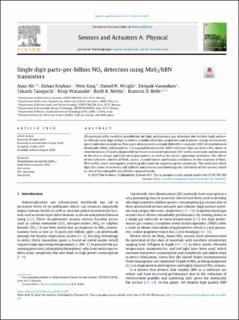| dc.contributor.author | Ali, Ayaz | |
| dc.contributor.author | Koybasi, Ozhan | |
| dc.contributor.author | Xing, Wen | |
| dc.contributor.author | Wright, Daniel Nilsen | |
| dc.contributor.author | Varandani, Deepak | |
| dc.contributor.author | Taniguchi, Takashi | |
| dc.contributor.author | Watanabe, Kenji | |
| dc.contributor.author | Mehta, Bodh R. | |
| dc.contributor.author | Belle, Branson | |
| dc.date.accessioned | 2020-10-12T12:37:57Z | |
| dc.date.available | 2020-10-12T12:37:57Z | |
| dc.date.created | 2020-08-11T15:59:30Z | |
| dc.date.issued | 2020 | |
| dc.identifier.issn | 0924-4247 | |
| dc.identifier.uri | https://hdl.handle.net/11250/2682270 | |
| dc.description.abstract | 2D materials offer excellent possibilities for high performance gas detection due to their high surface-to-volume ratio, high surface activities, tunable electronic properties and dramatic change in resistivity upon molecular adsorption. This paper demonstrates a simple field effect transistor (FET) of molybdenum disulphide (MoS2) fabricated on a hexagonal boron nitride (hBN) substrate that can detect NOx down to concentrations of 6 ppb and possibly far below at room temperature (RT) with a systematic optimization of the device design and fabrication parameters as well as the device operating conditions. The effects of the substrate, number of MoS2 layers, channel layout and biasing conditions on the response of MoS2 FETs to NOx were investigated, providing directions for maximizing the sensitivity. This work also sheds light the issues of recovery and stability and present a methodology for calibration of the sensors which is critical for repeatable and reliable measurements. | en_US |
| dc.language.iso | eng | en_US |
| dc.publisher | Elsevier | en_US |
| dc.rights | Attribution-NonCommercial-NoDerivatives 4.0 Internasjonal | * |
| dc.rights.uri | http://creativecommons.org/licenses/by-nc-nd/4.0/deed.no | * |
| dc.subject | Molybdenum disulphide | en_US |
| dc.subject | MoS2 | en_US |
| dc.subject | Field effect transistor | en_US |
| dc.subject | FET | en_US |
| dc.subject | Gas sensor | en_US |
| dc.subject | NOX detection | en_US |
| dc.subject | Sensitivity | en_US |
| dc.title | Single digit parts-per-billion NOx detection using MoS2/hBN transistors | en_US |
| dc.type | Peer reviewed | en_US |
| dc.type | Journal article | en_US |
| dc.description.version | publishedVersion | en_US |
| dc.rights.holder | © 2020 The Authors | en_US |
| dc.source.pagenumber | 7 | en_US |
| dc.source.volume | 3015 | en_US |
| dc.source.journal | Sensors and Actuators A-Physical | en_US |
| dc.identifier.doi | 10.1016/j.sna.2020.112247 | |
| dc.identifier.cristin | 1822831 | |
| dc.relation.project | Norges forskningsråd: 280788 | en_US |
| dc.relation.project | Norges forskningsråd: 295864 | en_US |
| cristin.ispublished | true | |
| cristin.fulltext | original | |
| cristin.qualitycode | 1 | |

